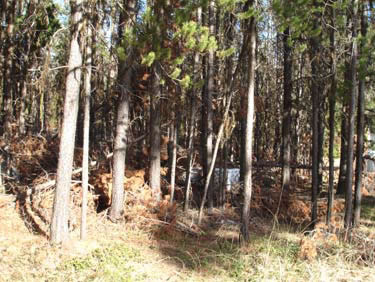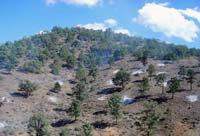
National Fire Plan Success Story
Manhattan Thinning Operations Help Make Remote Community "Fire-Safe"

Pinyon and juniper vegetation covering the project area.
A multi-year project to thin pinion and juniper woodlands and protect the small town of Manhattan, Nevada from the dangers of wildland fire has gone a long way toward the ultimate goal of making the community "Fire-Safe."
The local Firesafe Council chapter and the Bureau of Land Management (BLM) are currently working together to obtain grants that will enable them to address hazardous fuel issues inside the town. In addition, they have recently obtained grant funding to work in areas where the BLM is unable to work because of land ownership issues. The local chapter has systematically worked to plug gaps in the Fire Defense System in order to solidify the project and make Manhattan truly "Fire-Safe."
The Manhattan Wildland Urban Interface Hazardous Fuels Reduction Project is a multi-year, phased project currently in its fourth year of implementation. This interagency project is led by the BLM Battle Mountain Field Office (BMFO). The BLM's partners include the Manhattan Chapter of the Nevada Firesafe Council, Nevada Division of Forestry (NDF) the Humboldt-Toiyabe National Forest (USFS).
The purpose of the project is to protect the historic mining town of Manhattan from the types of Nevada wildfires that typically occur in pinion-juniper forest lands. Manhattan is located in a heavily forested canyon of the Toquima Mountain Range. The project provides for safe access routes for firefighters and escape routes for the community, in addition to providing a buffer zone around the community. The project is designed to protect the town and infrastructure from a crown fire advancing from any direction.
BLM collaborated with its interagency partners to educate the residents of this mountain community about the extreme risk their small town faced from wildland fires on nearby public lands. Residents also recognized that their own community lands posed a serious wildfire risk. The community provided significant input into the proposed action, which was incorporated into the resulting Environmental Assessment (EA).
Based on BLM advice and guidance, the community formed one of the first Nevada Firesafe Council chapters outside the Sierra Front. Formed in 2003, the council included nearly every permanent and seasonal resident of Manhattan. The local chapter further developed plans to implement a critical piece of the fuel break and used a grant provided by the Nevada Firesafe Council to create a 20-acre shaded fuel break at a strategic location on private land. This work was completed in 2004 and tied in perfectly with the fuel break on public land. As a result, the overall effectiveness of the entire project was strengthened.
BLM's NDF partners have been the real workhorse behind the project's success. They have done the majority of the thinning and chipping operations on both public and private lands. Their efforts on this project and dedication to stewardship and community safety have proven paramount to the success of this project. The BLM has been able to partner with NDF because of an existing Interagency Agreement for Fire Management. BLM has been able to fund NDF work on this project and deploy a large, cost-effective, local workforce.

Hillside after a presribed burn.
Managing the large amounts of slash and tree material generated from thinning operations has been one of the greatest challenges. Pinion and juniper trees are not considered "merchantable timber," but their wood can be used as fuel for wood stoves and fireplaces or chips for use in co-generation power plants.
Unfortunately, no cost effective method exists for transporting fuel wood or wood chips from the site to these kinds of power plants. The BLM allows the public to use the wood for home heating, and crews will often leave large chip piles for people to use as mulch in their flower beds. But such uses only dispose of a fraction of the slash and tree material, which are known as "activity fuels." Most of these materials are either chipped back onto the ground (where accessible by the chipper) or burned in piles.
The local ecosystem has benefited greatly from these thinning and prescribed fire operations. When crews thin out sick and dying trees along with excessive under-story trees, the competition for nutrients and water resources is considerably reduced among the remaining trees. The healthier trees that remain after thinning operations are completed can take advantage of these resources and grow larger and more resilient to common plant diseases such as dwarf mistletoe and other pests such as boring beetles. Crews leave about 30 trees per acre on-site with a diversity of age-classes.
The many prescribed fires conducted on the project have also proven beneficial to the local ecosystem. Although burns are only conducted on a small scale, many nutrients are recycled back into the ground on the periphery of the piles. BLM's post-burn monitoring has noted regeneration of such under-story species such as sagebrush, native grasses, bitterbrush, and Mormon tea.
These successful operations have also increased public awareness of the usefulness and necessity of prescribed fire in such fire-dependant ecosystems as pinion-juniper and sagebrush fuel types. The project has not only succeeded in achieving its primary goal of protecting lives, property and resources, however. It has also reaffirmed BLM's role in collaboration, cooperation and stewardship, and moreover has increased the level of public trust among those who call Manhattan, Nevada home.